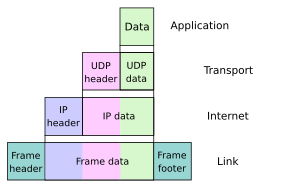The TCP/IP protocol suite is used in internet was developed prior to OSI model. Therefore the layers used in Transmission control protocol/Inter networking protocol are different from layers in OSI model.
The TCP/IP protocol is made of five layers; physical,data link, network, transport and application layer. The first four layers provide the physical standards, network interface, inter-networking and transport functions that correspond to first four layers of OSI model.
In TCP/IP protocol the top three layers are shown by single application layer. The different modules in TCP/IP suite are relatively independent and changes as per the need of system. The term hierarchical means top layer is supported by below layers.
At transport layer TCP/IP defines the transmission control protocol(TCP) and user datagram protocol(UDP)
At network layer the inter-networking protocol is defined(IP). Some data movement protocols are also supported on this layer.
The TCP/IP protocol is made of five layers; physical,data link, network, transport and application layer. The first four layers provide the physical standards, network interface, inter-networking and transport functions that correspond to first four layers of OSI model.
In TCP/IP protocol the top three layers are shown by single application layer. The different modules in TCP/IP suite are relatively independent and changes as per the need of system. The term hierarchical means top layer is supported by below layers.
At transport layer TCP/IP defines the transmission control protocol(TCP) and user datagram protocol(UDP)
At network layer the inter-networking protocol is defined(IP). Some data movement protocols are also supported on this layer.
 Image via Wikipedia
Image via Wikipedia











